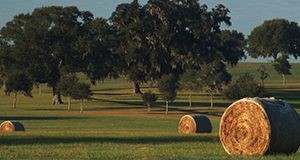Abstract
The dimensions of large round bales make a difference in many cases. Bale size determines the amount of hay in a purchased bale, the amount of nutrients in pounds, and the extent of spoilage during storage and feeding. Large round bales, the predominant form of hay made and fed to cattle, are under discussion. This 3-page fact sheet is a new document that examines the significance of bale dimensions, volume, density, and weight as well as the relationship of these factors to hay prices. Written by Matt Hersom, Todd Thrift, and Joel Yelich, and published by the UF Department of Animal Sciences, June 2016.
AN326/AN326: Implications of Round Bale Dimensions on Hay Use (ufl.edu)
References
Hersom, M., T. Thrift, and J. Yelich. 2010. Basic Nutrient Requirements of Beef Cows. AN190. Gainesville: University of Florida Institute of Food and Agricultural Sciences. http://www.edis.ifas.ufl.edu/an190
Hersom, M., T. Thrift, and J. Yelich. 2014. Comparison of Hay or Round Bale Silage as a Means to Conserve Forage. AN266. Gainesville: University of Florida Institute of Food and Agricultural Sciences. http://www.edis.ifas.ufl.edu/an266

